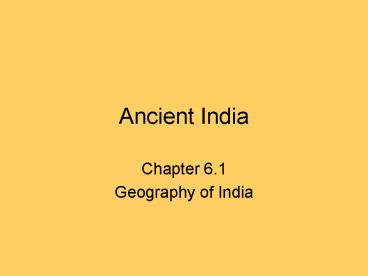Ancient India - PowerPoint PPT Presentation
1 / 28
Title: Ancient India
1
Ancient India
- Chapter 6.1
- Geography of India
2
Bellwork THINK! 1. From where are the first
people said to have migrated?2. After early
people decided to stop hunting and gathering
their food, why do you think they chose to settle
in these areas of the world?3. Can you name
these ancient civilizations?
3
After migrating north from Africa, early people
settled along the Indus River to start their
communities. Just like other civilizations, they
started to farm and build their own communities
by setting up a unique written language, trade
system, and government.
4
The Geography of India
- India is a subcontinent
- Large landmass
- Smaller than a continent
- Part of the continent of Asia
5
Mountains, Plains, Valleys, and Rivers Oh my!To
what region in India would you migrate?
6
Major Geographic Landforms
- Himalayas- northern border
- Ganges and Indus Rivers most important rivers
- Deccan Plateau makes up southern part
Himalayas
Deccan Plateau
7
Mountains
- Himalayas
- Tallest mountain range in the world
- Contains Mt. Everest
- Tallest mountain peak in the world
- 29,000 feet tall (5.5 miles)
8
Mountains
- Hindu Kush
- Border India to the northwest
9
Plains and Valleys
- Fertile plains at the foot of the mountains
- Ganges Plain, Indus River Valley
- Owe rich soil to 3 great rivers
- Indus River
- Ganges River
- Brahmaputra River
- Rivers provide farming, transportation, trade
10
3 Major Rivers
- 1) Indus River major river in Asia
- Flows through Pakistan
- Fed from glaciers in Himalayas
11
2) Ganges River
- Located in plains of northern India
- Holy River of Hinduism
- For most of its course it is a wide and sluggish
stream, flowing through one of the most fertile
and densely populated regions in the world.
Despite its importance, its length of 1,560 miles
(2,510 km) is relatively short compared with the
other great rivers of Asia or of the world.
12
3) Brahmaputra River
- major river of Central and South Asia.
- It flows some 1,800 miles (2,900 km) from its
source in the HIMALAYAS to its confluence with
the GANGES (GANGA) RIVER, - For most of its length, the river serves as an
important inland waterway it is not, however,
parts of it you can not travel on - In its lower course the river is both a creator
and a destroyerdepositing huge quantities of
fertile soil but also causing disastrous and
frequent floods.
13
Other Landforms
- Along west coast, fertile lands
- Inland are two chains of mountains (Western and
Eastern Ghats) - Between mountains Deccan Plateau
14
Climate
- Monsoons-seasonal winds
- Winter-monsoons blow cold, dry air from Himalaya
east to west - Summer-warmer land temperatures cause the winds
to change direction. Winds blow west to
east-bring warm, wet air and pouring rains
15
The Indus Valley Civilizations
- About 5,000 years ago, nomads settled in Indus
River Valley - Think -- 3 reason Why do you think they settled
here? - Modern day Pakistan
- Spread over western
- India and Pakistan
16
Work on and study all your student notes on Ch. 6
India (2 pages)
- Quiz tomorrow over India Vocab and Map
17
(No Transcript)
18
The Indus Valley Civilizations
- About 5,000 years ago, nomads settled in Indus
River - Modern day Pakistan
- Spread over western India and Pakistan
19
Indus Valley Civilization
- Indus River Valley
- 2600 B.C. 1900 B.C.
- Most were farmers
20
Harappa and Mohenjo-Daro
- Large cities
- Houses made of mud bricks
- Indoor plumbing
- Left no written records
21
Aryan Migrations and Settlements
- c.1900 B.C Indus Valley people left
- - drought
- - earthquakes and floods
- Aryans came from Asia
- - Ruled by rajas (prince)
22
Writing
- Aryans developed a written language, Sanskrit
- Vedas
- - sacred texts
- - songs, stories, and prayers
23
Caste System
24
Caste System
- Aryans developed social classes or groups
- Could never change groups
- Rules for life (marriage, work, and friendship)
- 4 classes called the varnas
25
Caste System
- The Brahmins were at the top
- - priests
- - most power
- Next were the Kshatriyas or the warriors
- Ran the government and army
26
Caste System
- Vaisyas
- - common people
- - farmers, craftspeople, and merchants
- Sudras
- manual workers and servants
- few rights
- largest group
27
Caste System
- Untouchables
- - too low to even be part of the system
- - live apart
- - did the dirty work
28
The Untouchables Video
- http//youtu.be/j31veR74gSo 7 mins































